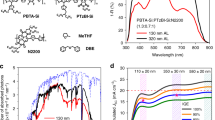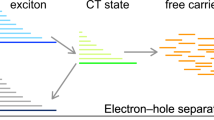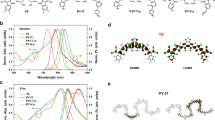Abstract
There are two crucial tasks for realizing high-efficiency polymer solar cells (PSCs): increasing the range of the spectral absorption of light and efficiently harvesting photogenerated excitons. Here, we describe Förster resonance energy transfer-based heterojunction polymer solar cells that incorporate squaraine dye. The high absorbance of squaraine in the near-infrared region broadens the spectral absorption of the solar cells and assists in developing an ordered nanomorphology for enhanced charge transport. Femtosecond spectroscopic studies reveal highly efficient (up to 96%) excitation energy transfer from poly(3-hexylthiophene) to squaraine occurring on a picosecond timescale. We demonstrate a 38% increase in power conversion efficiency to reach 4.5%, and suggest that this system has improved exciton migration over long distances. This architecture transcends traditional multiblend systems, allowing multiple donor materials with separate spectral responses to work synergistically, thereby enabling an improvement in light absorption and conversion. This opens up a new avenue for the development of high-efficiency polymer solar cells.
This is a preview of subscription content, access via your institution
Access options
Subscribe to this journal
Receive 12 print issues and online access
$209.00 per year
only $17.42 per issue
Buy this article
- Purchase on Springer Link
- Instant access to full article PDF
Prices may be subject to local taxes which are calculated during checkout




Similar content being viewed by others
References
Krebs, F. C., Gevorgyan, S. A. & Alstrup, J. A roll-to-roll process to flexible polymer solar cells: model studies, manufacture and operational stability studies. J. Mater. Chem. 19, 5442–5451 (2009).
Krebs, F. C. et al. A complete process for production of flexible large area polymer solar cells entirely using screen printing—first public demonstration. Solar Ener. Mater. Solar Cells 93, 422–441 (2009).
Tipnis, R. et al. Large-area organic photovoltaic module—fabrication and performance. Solar Ener. Mater. Solar Cells 93, 442–446 (2009).
Li, G., Zhu, R. & Yang, Y. Polymer solar cells. Nature Photon. 6, 153–161 (2012).
Li, G. et al. High-efficiency solution processable polymer photovoltaic cells by self-organization of polymer blends. Nature Mater. 4, 864–868 (2005).
Ma, W. L., Yang, C. Y., Gong, X., Lee, K. & Heeger, A. J. Thermally stable, efficient polymer solar cells with nanoscale control of the interpenetrating network morphology. Adv. Funct. Mater. 15, 1617–1622 (2005).
Irwin, M. D., Buchholz, B., Hains, A. W., Chang, R. P. H. & Marks, T. J. P-type semiconducting nickel oxide as an efficiency-enhancing anode interfacial layer in polymer bulk-heterojunction solar cells. Proc. Natl Acad. Sci. USA 105, 2783–2787 (2008).
Huang, J.-S., Chou, C.-Y. & Lin, C.-F. Efficient and air-stable polymer photovoltaic devices with WO3–V2O5 mixed oxides as anodic modification. IEEE Electron. Dev. Lett. 31, 332–334 (2010).
Bundgaard, E. & Krebs, F. C. Low band gap polymers for organic photovoltaics. Solar Ener. Mater. Solar Cells 91, 954–985 (2007).
Kroon, R., Lenes, M., Hummelen, J. C., Blom, P. W. M. & de Boer, B. Small bandgap polymers for organic solar cells (polymer material development in the last 5 years). Polym. Rev. 48, 531–582 (2008).
Lee, J. K. et al. Processing additives for improved efficiency from bulk heterojunction solar cells. J. Am. Chem. Soc. 130, 3619–3623 (2008).
Park, S. H. et al. Bulk heterojunction solar cells with internal quantum efficiency approaching 100%. Nature Photon. 3, 297–302 (2009).
Moon, J. S. et al. Effect of processing additive on the nanomorphology of a bulk heterojunction material. Nano Lett. 10, 4005–4008 (2010).
Lou, S. J. et al. Effects of additives on the morphology of solution phase aggregates formed by active layer components of high-efficiency organic solar cells. J. Am. Chem. Soc. 133, 20661–20663 (2011).
Peet, J., Senatore, M. L., Heeger, A. J. & Bazan, G. C. The role of processing in the fabrication and optimization of plastic solar cells Adv. Mater. 21, 1521–1527 (2009).
Kirchartz, T., Taretto, K. & Rau, U. Efficiency limits of organic bulk heterojunction solar cells. J. Phys. Chem. C 113, 17958–17966 (2009).
Hardin, B. E., Snaith, H. J. & McGehee, M. D. The renaissance of dye-sensitized solar cells. Nature Photon. 6, 162–169 (2012).
Hardin, B. E. et al. Increased light harvesting in dye-sensitized solar cells with energy relay dyes. Nature Photon. 3, 406–411 (2009).
Driscoll, K. et al. Enhanced photoresponse in solid-state excitonic solar cells via resonant energy transfer and cascaded charge transfer from a secondary absorber. Nano Lett. 10, 4981–4988 (2010).
Hardin, B. E. et al. High excitation transfer efficiency from energy relay dyes in dye-sensitized solar cells. Nano Lett. 10, 3077–3083 (2010).
Mor, G. K. et al. High-efficiency Förster resonance energy transfer in solid-state dye sensitized solar cells. Nano Lett. 10, 2387–2394 (2010).
Mor, G. K. et al. Visible to near-infrared light harvesting in TiO2 nanotube array-P3HT based heterojunction solar cells. Nano Lett. 9, 4250–4257 (2009).
Chen, Y.-C., Hsu, C.-Y., Lin, R., Ho, K.-C. & Lin, J. Materials for the active layer of organic photovoltaics: ternary solar cell approach. ChemSusChem 6, 20–35 (2013).
Belcher, W. J., Wagner, K. I. & Dastoor, P. C. The effect of porphyrin inclusion on the spectral response of ternary P3HT:porphyrin:PCBM bulk heterojunction solar cells. Solar Ener. Mater. Solar Cells 91, 447–452 (2007).
Cooling, N. et al. A study of the factors influencing the performance of ternary MEH-PPV:porphyrin:PCBM heterojunction devices: a steric approach to controlling charge recombination. Solar Ener. Mater. Solar Cells 95, 1767–1774 (2011).
Koppe, M. et al. Near IR sensitization of organic bulk heterojunction solar cells: towards optimization of the spectral response of organic solar cells. Adv. Funct. Mater. 20, 338–346 (2010).
Honda, S., Ohkita, H., Benten, H. & Ito, S. Selective dye loading at the heterojunction in polymer/fullerene solar cells. Adv. Ener. Mater. 1, 588–598 (2011).
Ameri, T. et al. Performance enhancement of the P3HT/PCBM solar cells through NIR sensitization using a small-bandgap polymer. Adv. Ener. Mater. 2, 1198–1202 (2012).
Yang, L., Zhou, H., Price, S. C. & You, W. Parallel-like bulk heterojunction polymer solar cells. J. Am. Chem. Soc. 134, 5432–5435 (2012).
Lobez, J. M., Andrew, T. L., Bulović, V. & Swager, T. M. Improving the performance of P3HT–fullerene solar cells with side-chain-functionalized poly(thiophene) additives: a new paradigm for polymer design. ACS Nano 6, 3044–3056 (2012).
Silvestri, F. et al. Efficient squaraine-based solution processable bulk-heterojunction solar cells. J. Am. Chem. Soc. 130, 17640–17641 (2008).
Wei, G. et al. Functionalized squaraine donors for nanocrystalline organic photovoltaics. ACS Nano 6, 972–978 (2012).
Kim, Y. et al. A strong regioregularity effect in self-organizing conjugated polymer films and high-efficiency polythiophene:fullerene solar cells. Nature Mater. 5, 197–203 (2006).
Lakowicz, J. R. in Principles of Fluorescence Spectroscopy Ch.13 (Springer, 2006).
Sapsford, K. E., Berti, L. & Medintz, I. L. Materials for fluorescence resonance energy transfer analysis: beyond traditional donor–acceptor combinations. Angew. Chem. Int. Ed. 45, 4562–4589 (2006).
Sheng, C. X., Tong, M., Singh, S. & Vardeny, Z. V. Experimental determination of the charge/neutral branching ratio η in the photoexcitation of π-conjugated polymers by broadband ultrafast spectroscopy. Phys. Rev. B 75, 085206 (2007).
Handlin, D. L. & Thomas, E. L. Visualization of ordered spherical microdomains of block copolymers by phase contrast electron microscopy. J. Mater. Sci. 3, 137–140 (1984).
van Bavel, S. S., Bärenklau, M., de With, G., Hoppe, H. & Loos, J. P3HT/PCBM bulk heterojunction solar cells: impact of blend composition and 3D morphology on device performance. Adv. Funct. Mater. 20, 1458–1463 (2010).
Xie, Y. et al. Femtosecond time-resolved fluorescence study of P3HT/PCBM blend films. J. Phys. Chem C 114, 14590–14600 (2010).
Huang, J.-H., Chien, F.-C., Chen, P., Ho, K.-C. & Chu, C.-W. Monitoring the 3D nanostructures of bulk heterojunction polymer solar cells using confocal lifetime imaging. Anal. Chem. 82, 1669–1673 (2010).
Marsh, R. A., Hodgkiss, J. M., Albert-Seifried, S. & Friend, R. H. Effect of annealing on P3HT:PCBM charge transfer and nanoscale morphology probed by ultrafast spectroscopy. Nano Lett. 10, 923–930 (2010).
Tian, M. et al. Search for squaraine derivatives that can be sublimed without thermal decomposition. J. Phys. Chem. B 106, 4370–4376 (2002).
Acknowledgements
This work was supported primarily by the SOLAR program of the National Science Foundation (NSF; DMR-0934520) and the Yale Climate and Energy Institute. A.D.T. acknowledges support from a NSF-CAREER award (CBET-0954985) and NASA (CT Space Grant Consortium). Research was carried out in part at the Centre for Functional Nanomaterials, Brookhaven National Laboratory, which is supported by the US Department of Energy, Office of Basic Energy Sciences (contract no. DE-AC02-98CH10886). The authors thank C. Schmuttenmaer, E. Yan and S. Wang for informative discussions.
Author information
Authors and Affiliations
Contributions
J.-S.H. and A.D.T. conceptualized the project. J.-S.H. designed and performed the device experiments and data analysis. J.-S.H., T.G. and M.Y.S. performed the ultrafast experiments and resulting data analysis. J.-S.H., T.G. and X.L. performed TEM experiments. J.-S.H., S.T. and M.L. performed the EQE experiments. E.A.B. and N.H. synthesized the SQ dye. A.D.T and J.-S.H. laid out the design of the manuscript. J.-S.H. wrote the original manuscript and all authors contributed equally towards improving it.
Corresponding author
Ethics declarations
Competing interests
The authors declare no competing financial interests.
Supplementary information
Supplementary information
Supplementary information (PDF 1205 kb)
Rights and permissions
About this article
Cite this article
Huang, JS., Goh, T., Li, X. et al. Polymer bulk heterojunction solar cells employing Förster resonance energy transfer. Nature Photon 7, 479–485 (2013). https://doi.org/10.1038/nphoton.2013.82
Received:
Accepted:
Published:
Issue Date:
DOI: https://doi.org/10.1038/nphoton.2013.82
This article is cited by
-
Facile access to C-N bonds via unexpected side reactions of Knoevenagel condensation and their application in high-efficiency organic solar cells
Science China Chemistry (2024)
-
Models and mechanisms of ternary organic solar cells
Nature Reviews Materials (2023)
-
Depressed carrier recombination for organic solar cells by doping IEICO-4F molecule
Journal of Materials Science: Materials in Electronics (2023)
-
Strong connection between PVK and ETL induced by an anti-allergic agent interface for high-quality PSCs
Journal of Materials Science: Materials in Electronics (2022)
-
Pseudo-bilayer architecture enables high-performance organic solar cells with enhanced exciton diffusion length
Nature Communications (2021)



